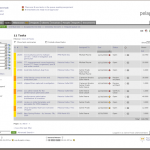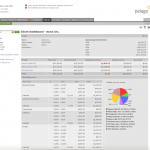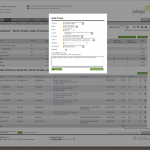Review: Intervals for Project Management and Time Accounting
 At R7 Solutions, in addition to GeoRoom, GeoIntelis (and soon to be announced GeoDomis), a good percentage of what we do is to provide professional services.
At R7 Solutions, in addition to GeoRoom, GeoIntelis (and soon to be announced GeoDomis), a good percentage of what we do is to provide professional services.
We provide software engineering, business process design and strategic IT consulting. Just like any professional services firm, that means keeping close track of projects, tasks and hours.
And we’re a highly technical company selling business automation to our clients, so we hate doing things on paper when a better option is available. And for project management and hours accounting, we’ve tried them all.
Oh, boy, have we tried them all:
- Paper
- Microsoft Project Server 2003
- QuickBooks Timer
- Paper again
- ScoutSoft StandardTime
- Axosoft OnTime
(We also looked at WorkEtc.com, DeskAway.com and BaseCamp.com.)
Finally, in 2009, we tried Intervals.
I have to give Intervals an unreserved endorsement. It does everything I need to run a professional services firm. It does it gracefully and works almost entirely as you’d expect it to work by looking at it. No training was required to use 90% of the features.
Intervals has the face of a project manager, the heart of a Web 2.0 AJAX app, but the soul of an accountant. And as a manager and owner, that’s why I love it.
Here are our favorite things about Intervals:
- It is 100% web-based and hosted Software-as-a-Service. This means we don’t have to install or maintain anything. We like this.
- It is sophisticated enough to allow us to develop complete multi-level project plans, and create time estimates and budgets. This is where a lot of online systems fall down.
- However, be warned, it doesn’t do Gantt charts and it doesn’t work like MS Project. If you want that, start from Project, but use Intervals to actually manage the project and hours.

- It is quite affordable for the SMB. Monthly subscription prices range from $20 to $175 per month, based on number of active projects. All features are available in all versions. As the lifeblood of our professional services firm, it is an absolute steal. I’m certain it has paid for itself many time over in re-captured hours, better project planning and tracking, and better and more consistent client communications.
- It provides direct upload of hours to QuickBooks, provided you set up the Projects in Intervals to directly match your Jobs in QuickBooks. We are still experimenting with these features and do some manual data entry into QuickBooks based on a summary from Intervals, but they do appear to work correctly.
- We use Intervals to track our billables and invoices. It does this job very well. Its “project dashboard” provides me with an instantaneous view into the current billable hours, invoiced and un-invoiced. Doing reconciliations, reviews, budget management, revisions and discounts used to take hours. Now, we can do almost anything required in minutes, and make it online and available to the business manager in the client at the time I make the change.

- Intervals provides a client portal. This is killer. For me, this immediately pushed me to test Intervals. Providing direct client access is the holy grail of project management, for us. It provides a whole new level of interactivity, collaboration and accountability for our projects, all of which we love. Clients can be assigned to projects as “Executives” and can review the project task assignments and status, hours and billings directly. They can review invoices. The only thing they can’t do is pay their invoices. Intervals isn’t an e-commerce system, although it could be in the future. In any case, we use Intuit’s services for those purposes, which keeps our accounting easy and accurate.
- Intervals provides great time sheet management. Time sheets are expected weekly and template-based e-mail reminders can be sent to consultants who are late. Time sheets are locked once submitted, which saves a lot of confusion. Time sheet management is easy and fast for managers. You can drill down into details to check on which projects and tasks absorbed the time, and manager approvals are one click. Just one caveat: Be very careful as a manager if you change hours after a time sheet has been approved. This can cause confusion in the invoicing process. It can all be fixed, but it does take a little research.

- Intervals wants to look and work a little like a social network. You can load a photo for each registered user and this photo shows up every time that user is referenced. Any time you create or change a task, project, comments, hours estimate, etc., the change is tracked
 in a post a the bottom of the item. This can be a bit much to look at for tasks that are in planning and receive a lot of changes, but it is at the bottom of the page and easily ignored most of the time.
in a post a the bottom of the item. This can be a bit much to look at for tasks that are in planning and receive a lot of changes, but it is at the bottom of the page and easily ignored most of the time. - There is a limit to the amount of interface customization you can do: If you want to present your clients with a complete white label solution, this isn’t it. You can add a logo to the top and are given a URL at “https://companyname.intervalsonline.com.”
- You can allow clients to directly e-mail or fill out a form in Intervals to make a new task request. These show up in a general queue in Intervals and must be manually categorized and assigned. Intervals does not have a directly embeddable form for task requests, but maybe that will come later. In the mean time, it is easy to use a conventional e-mail form on your website to e-mail tasks to the queue.
- Ad hoc reporting could be strengthened, but you can customize most views to include the fields you need, and do a quick print out from the screen. Also, most data grid and other screens in Intervals allow you to quickly generate an Excel .xls, PDF or e-mail to share data, where appropriate.
Overall, I can’t recommend this SaaS highly enough.
I’ve been exhausted and frustrated by previous systems. Intervals never exhausts or frustrates me. It has quirks, like any system, and it requires organization and process, just like any project management or time accounting system, but it is certainly the best we’ve found.
Need help with your business? Contact JumpPhase.com
Kraettli Lawrence Epperson
Latest posts by Kraettli Lawrence Epperson (see all)
- Do entrepreneurs do their own taxes? - August 31, 2019
- A venture capital firm asks to interview you; What do you do? - August 31, 2019
- If I want to eventually start my own company, will product management experience help? - January 3, 2019
We had a question about how long it took us to get Intervals up and running, so here are some supplemental comments:
I’d say it took me a few hours of working with it to get comfortable, and one to two billing cycles for our business manager to be completely comfortable.
The amount of setup we had to do, however, was a lot less than I’ve seen with other systems. I really just started using it half-seriously without making a lot of modifications, found I liked it, and started making changes as I went along.
We mostly just let it do its thing and trust that it does it right – which it has, 99% of the time.
The only time we screw up is when we change hours after the time sheet has been approved (all my mistakes) or when we forget that the default billing rate for a particular role (“Senior Software Engineer”) needs to be changed in a new project (also my mistake – my business manager corrected both).
It really only does basic project planning – a task list with hours estimate – but most of the time, that’s all we need. You can attach documents and notes to projects and tasks, so details can go there.
One of the features I really love is the ability to put some tasks “On Hold” so that we have the complete project plan, the software specification documented, and the estimate, but haven’t authorized the work until the client says “Go.”
I now consider Intervals to be one of our competitive advantages.